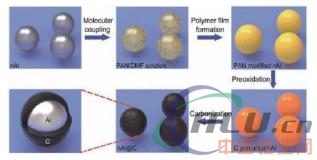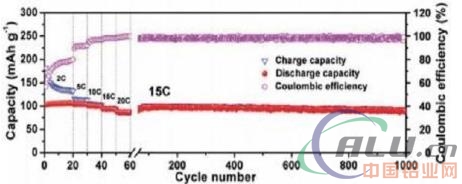ã€ALUMINIUM CHINA NETWORK】 Recently, Tang Yongbing, a researcher at the Functional Film Materials Research Center of the Shenzhen Institute of Advanced Technology, Chinese Academy of Sciences, and Gu Lin, a researcher at the Institute of Physics of the Chinese Academy of Sciences, have developed aluminum-carbon nanosphere composites with a core-shell structure. And apply to high-efficiency, low-cost dual-ion batteries. This new structure effectively solves the problems of volume expansion and poor cycling performance of aluminum anode materials during charge and discharge. Relevant research results have been published on Advanced Energy Materials online with the topic Core-Shell Aluminum Carbon Nanospheres for Dual-Ion Batteries with Excellent Cycling Performance under High Rates.

Fig.1 Design and preparation of core-shell aluminum-carbon nanocomposites

Fig.2 Long cycle stability curve of double-ion battery prepared at 15C charge and discharge speed
ã€research content】
With the development of the market scale of portable electronic devices and electric vehicles, people's demand for high-energy density, low-cost secondary batteries has become increasingly urgent. At present, commercial lithium ion batteries are mostly made of graphite anode materials, the theoretical specific capacity is only 372 mAh/g, and the compaction density is low, which limits the energy density of lithium ion batteries further. By alloying/dealloying with lithium ions, inexpensive metal anodes generally have a larger specific capacity and are expected to achieve higher energy densities. Among them, the theoretical specific capacity of aluminum is as high as 2234mAh/g (Li9Al4), and its reserves are abundant and the price is low. However, the aluminum negative electrode will have a certain volumetric expansion during the battery reaction process, leading to material pulverization, thereby affecting the cycle stability of the battery.
Based on the above considerations, Tang Yongbing's research team developed an aluminum-carbon nanosphere composite with a core-shell structure and used it as a negative electrode material and natural graphite as a positive electrode material to develop a novel high-efficiency, low-cost dual-ion secondary battery. . Compared to traditional lithium-ion batteries, the new secondary energy storage battery has a higher operating voltage (average discharge voltage of -4.2V) and is environmentally friendly. In addition, since the core-shell nanostructure effectively relieves the volume expansion of the aluminum negative electrode during the alloying process and a highly stable SEI film is obtained, the cycle stability of the battery is greatly improved. The results show that the new battery has a capacity retention rate as high as 94.6% after 1000 cycles at a charge and discharge rate of 15C (4 minutes charge and discharge); even at a power density of 3701 W/kg, the battery has an energy density of 148 Wh/. Kg, much higher than most commercial lithium-ion batteries. This achievement has guiding significance for the research on the modification of cheap metal anode materials and is expected to promote the rapid development of high-energy, low-cost secondary batteries based on inexpensive metal anodes.
Touch Screen Bathroom Mirror,Touch Screen Vanity Mirror,Touch Light Bathroom Mirror,Led Touch Mirror For Bathroom
NINGBO EASTKEY ILLUMINATE APPLIANCE CO.,LTD , https://www.dkledmirrorlight.com